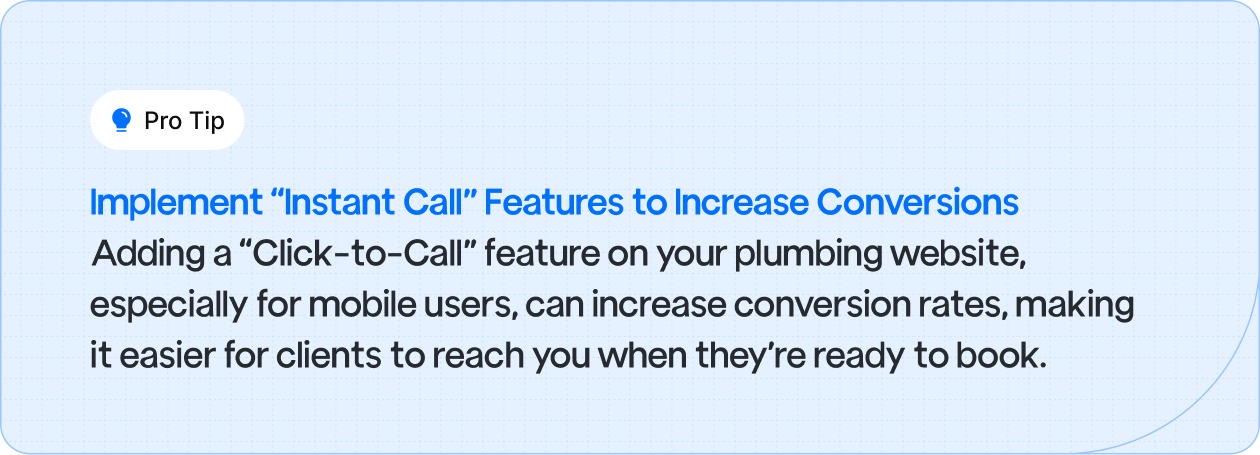Schedule a Call
Get started with your organic growth journey!




You might be providing reliable, honest plumbing work every day, yet the phone still isn’t ringing as often as it should. It’s not usually a problem with your service. It’s that people in your area aren’t finding you when they’re searching online for help.
When someone has a leak, a broken water heater, or a sudden plumbing issue, they search quickly for the first trusted business they can contact. If your business doesn’t show up in those local search results, the job goes to someone else before you even have a chance to talk to them. That gap between your quality of work and your online appearance can directly affect your bookings.
This guide focuses on closing that gap. We’ll walk through practical SEO steps that help your plumbing business show up locally, build trust faster, and make it simple for homeowners to reach you when they need help right away.
When we talk about plumbing leads, we’re referring to people or businesses who have expressed interest in plumbing services and could become paying customers. These leads are potential clients who require drain cleaning, pipe repair, water heater installation, or any other plumbing service and are actively seeking someone to hire.
Here’s what defines good plumbing leads:
By clearly understanding what plumbing leads are and what makes them good, you can refine your marketing efforts, tailor your messaging, and build systems that bring in leads that convert into real work.
When considering plumbing leads, it’s crucial to recognize what qualifies as a genuine opportunity for your business.
Generating high‑quality plumbing leads in 2025 means combining smart, modern tactics with consistent, well‑executed effort. Below are proven strategies that plumbers can rely on to attract customers and convert interest into jobs.
Your website is your first impression. It should be built to earn trust quickly and convert visitors into calls, quote requests, or bookings.
When to use it:
When you already receive traffic (website visits, Google Business Profile views) but the number of calls or appointment bookings is low. Or when you’re launching/re-launching a site and want it to serve as your lead-generation engine.
Actionable tips:
Benefits:
A high-performing website acts as your silent salesperson. It boosts credibility, increases conversion rates from visitor to lead, and reinforces your professionalism.
Point is: good website = good first impression = more leads.
For landscapers, Google’s “local pack” (map results) is prime real estate. Most people search and rarely scroll past those top listings.
When to use it:
When you serve a defined service zone (city, county, suburbs) and you want your business to show up in local search results (Google Maps, “near me” queries) for each area you cover.
Actionable tips:
Benefits:
Proper local SEO helps you show up when someone nearby searches for what you do. It puts you in the “map pack” and local results — the prime real estate for service-business searches.
You become visible to people already looking for a landscaper in your region, which means higher chance of booking.
Paid ads are the quickest way to reach clients who need landscaping now. They complement SEO by filling in gaps while organic rankings grow.
When to use it:
When you want faster results than organic SEO alone can deliver, or when you’re entering new service areas and want to dominate quickly. Also useful during peak seasons (e.g., spring/summer for landscaping) when demand is high.
Actionable tips:
Benefits:
Paid campaigns let you compete for leads now, not just later. When done smartly, this means you can funnel high-intent prospects into booked jobs more quickly, providing a more predictable flow of work.
People don’t hire landscapers they don’t trust. Positive reviews, visible testimonials, and community engagement are your strongest conversion assets.
When to use it:
When you’ve already completed jobs and have a satisfied client base. Also when you're operating in a competitive area and need to stand out.
Actionable tips:
Benefits:
Trust is everything in trades like landscaping. High review counts and positive ratings improve your perceived reliability and directly impact your ability to convert browsers into customers. Also, word-of-mouth (via referrals) typically brings warmer leads with higher conversion rates and lower acquisition costs.
Homeowners research before they hire, meaning educational content and consistent local visibility keep your brand top-of-mind long before a client reaches out.
When to use it:
When you want to nurture potential clients who aren’t ready to book yet (e.g., they’re comparing landscapers), or you want to build your brand so you show up consistently in your market.
Actionable tips:
Benefits:
Good content put you front-of-mind, even before someone actively searches. Over time, it builds familiarity, authority and trust. That means when a homeowner does look for a landscaper, you’re already a known option.
Micro-moments are high-intent searches like emergencies.
When to use it:
When people need a landscaper quickly. For example, prepping for an event, urgent lawn restoration after damage, or seasonal clean-up. These are “right-now” moments rather than long research journeys.
Actionable tips:
Benefits:
In these moments, prospects are ready to act. If you capture that urgency, with a clear CTA and visibility in their search, you beat competitors who are slower or harder to reach. This often leads to higher-value jobs and less price negotiation.
As Google’s AI and voice search evolve, structured data and FAQ-style content help your business appear in snippets and smart assistant answers.
When to use it:
When you’re ready to move beyond basic SEO and compete for high-visibility placements (snippets, voice search results, local 3-pack). Especially valuable if you’re in a saturated market.
Actionable tips:
Benefits:
By aligning with the way search engines and voice assistants pull data, you increase the chance of being featured in “quick answer” boxes or voice search results. That gives you a visibility boost and differentiates you from competitors who only do standard SEO.
Leads lose value by the minute. If you respond fast, you’re almost always the one they book.
When to use it:
When you’re receiving inquiries (calls or forms) but conversion to booked jobs remains low or slow. Especially relevant if you serve emergency or time-sensitive jobs.
Actionable tips:
Benefits:
Faster response increases trust and prevents prospects from choosing the competitor who called them first. Data shows phone leads convert faster and retain longer in the home services sector.
In the end, speed and clarity in response mean better conversion to booked jobs.
Most visitors don’t convert on their first visit. Remarketing helps bring them back, while recurring contracts stabilize your pipeline.
When to use it:
When a visitor came to your site but didn’t book, or when you serve clients who require ongoing services (maintenance, seasonal landscaping, commercial grounds). This is about staying visible and capturing larger opportunities.
Actionable tips:
Benefits:
Remarketing gives you a second chance to convert someone who showed intent but didn’t act immediately. Recurring contracts give you stability in workload and income.
Together, they improve the long-term value of your marketing efforts beyond one-off jobs.

Tracking shows what actually drives profitable jobs.
When to use it:
When you’re investing in several channels (organic SEO, paid ads, social media) and want to identify which are delivering truly valuable leads.
Actionable tips:
Benefits:
Data-driven optimisation means you don’t throw money at every channel and hope. You focus on what works. Over time, this reduces your cost per booked job, increases efficiency, and improves profitability of your marketing.
When you’re looking to attract plumbing leads, it’s important to recognise that not all leads are the same.
Let’s break down the main types of leads you’re likely to encounter:
These are plumbing leads from homeowners who have an urgent issue: burst pipes, major leaks, non‑working water heaters, sewer backups. They’re ready to hire immediately.
These plumbing leads come from homeowners needing a fix or tuning up of their plumbing system, not necessarily an emergency, but soon. Examples: clogged drains, dripping faucets, annual inspections.
Good marketing for these leads includes content showing you handle common problems, and offers of maintenance plans or inspections.
These plumbing leads come from homeowners or property managers looking to add or upgrade plumbing systems: new bathrooms, kitchen remodels, pipe upgrades, smart plumbing installations.
These jobs often have higher ticket values and longer decision‑making cycles. To attract these leads, you’ll want to show project galleries, case studies, service pages for remodeling work, and strong trust signals.
These plumbing leads originate from businesses, multi‑unit properties, or commercial buildings rather than individual homeowners. Their needs might include large‑scale plumbing installation, ongoing contract maintenance, or urgent commercial plumbing issues.
Beyond service need, plumbing leads also differ in how they’re acquired and shared: shared leads, exclusive leads, subscription lead‑services.
Understanding which type of leads you want (and can afford) is part of your lead generation strategy.
By recognising the variety of plumbing leads, emergency, repair/maintenance, installation, commercial, and lead‑delivery types, you can:
Attracting more plumbing leads isn’t just about being present; it’s about being found at the right time, in the right place. By applying the right strategies, you're setting your business up for sustainable growth and more clients.
It’s important to stay proactive and consistent with your approach to lead generation, but you don’t have to do it alone.
At Gushwork, we design to simplify the process of managing and growing your online presence, ensuring you stay visible to those who need your services. With the right strategy and support, you can drive more leads, build trust, and take your plumbing business to the next level. Let us help you get there!
1. How can I convert plumbing leads that are just browsing or researching?
To convert leads that are in the research phase, provide valuable content like blog posts, how-to guides, or free consultations. Offering educational resources can build trust and position your business as the go-to expert when they're ready to hire.
2. What is the most cost-effective way to generate plumbing leads for a small business?
Start by focusing on organic growth strategies like local SEO and word-of-mouth referrals. You can also engage with community groups on social media to create brand awareness. Paid ads work, but organic methods offer long-term sustainability with a lower upfront cost.
3. What kind of follow-up system works best for plumbing leads?
Implement a multi-step follow-up process, starting with an immediate acknowledgment of their inquiry. A combination of automated emails and personal phone calls ensures that the lead feels valued while providing timely responses to keep them engaged.
4. How can plumbing businesses target high-ticket leads for major installations?
For larger projects like installations and upgrades, focus on showcasing your expertise through detailed case studies, high-quality visuals, and customer testimonials. Marketing strategies should emphasize quality and reliability, along with offering free quotes or consultations to initiate contact.
.svg)